Pentax Q Review
Pentax Q
Pentax Q: compact system contender or overpriced advanced compact?
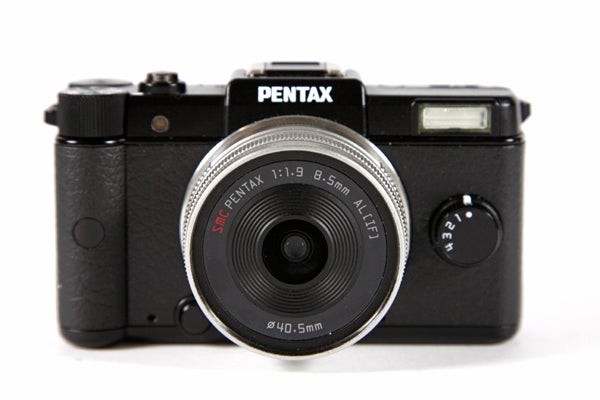
Verdict
Pros
- Spy-gadget compactness
- Good image quality
- Surprisingly good ISO performance
- Loads of creative/digital filter effects
Cons
- Limited depth of field
- Fiddly buttons
- Uncompetitive price
- Limited choice of compatible lenses
Key Specifications
- Review Price: £599.99
- 12.4-megapixels
- ISO 125 - 6400
- 1080p Full HD movies at 30fps
- 3in, 460k-dot LCD screen
- 9 Smart Effects / 19 Digital Filters
Looking rather like a miniaturised rangefinder (without a viewfinder), the Pentax Q offers a fresh take on the compact system genre by combining genuine pocketability with a generous feature-set and a wealth of easily accessed creative options. 
Working on the digital camera truism that bigger sensors require bigger lenses, Pentax has instead decided to keep everything as small as possible, and to this end the Q employs a 1/2.3in sensor – exactly the same size that’s found inside the vast majority of regular compacts. This allows tiny lenses to be attached to the newly developed Q mount.
This unique approach has, somewhat inevitably, led to some raised eyebrows from those who argue that fitting compact cameras with interchangeable lenses is a bit of a ludicrous idea. Those with a more positive outlook, however, might be inclined to argue that advancements in sensor technology in recent years give the Pentax Q every chance of succeeding. Either way, the Pentax Q marks the first time it has been tried on such a scale, and for that reason alone Pentax surely deserves some credit.
Given the way Pentax has approached the compact system market, it’s somewhat difficult to pinpoint its most direct competitors. The £600 price tag for a Pentax Q body and 8mm f/1.9 lens doesn’t make this any easier as it makes the full package more expensive than the Olympus E-PL3 body and 14-42mm pancake lens combo, or even the Sony NEX-C3 twin lens kit. You can also expect to see plenty of change from £600 should you decide to opt for either the Lumix G3 or Lumix GF3 standard zoom packages.
Should we even be thinking of the Pentax Q as a CSC, at all? Given the sensor size would it not be better compared against advanced compacts such as the Canon S100, Nikon S9100 or Lumix LX5? Either way, the Pentax Q clearly has its work cut out if it hopes to convince you to part with the best part of £600
Let’s take a closer look and find out if it can do this…
Overall, the Pentax Q is a very well appointed little camera that offers a generous feature set and plenty of scope for customisation. This very much mirrors what we’ve seen with Pentax DSLRs in recent years, as the company attempts to increase its market share by producing cameras that offer class-leading value for money.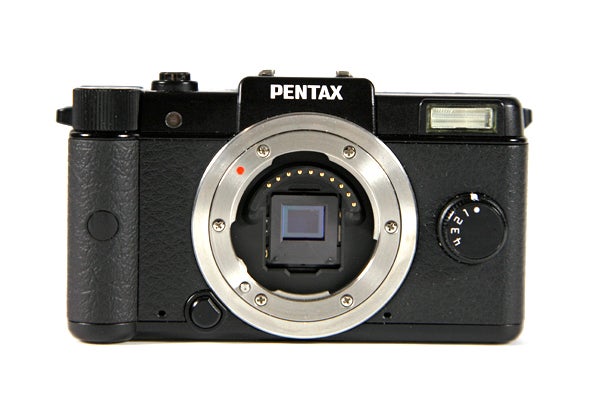
The Pentax Q is built around a 1/2.3inch CMOS sensor that is backside-illuminated for better low-light performance, and which delivers 12.4-megapixels of effective resolution. This is allied to what Pentax describes as a “new generation” of Q image processor that is claimed to deliver “clear, high contrast images rich in gradation and texture”. It’s a bold claim, and one that we’ll discuss the accuracy of in more detail later on in this review, but first let’s look at what else the Pentax Q offers in the way of specifications and features.
The Q can be set to record lossless Raw image files and compressed JPEGs at the full 12MP, with further options to record JPEGs at 9MP, 5MP and 3MP, with three levels of JPEG quality to choose from. While the default aspect ratio is 4:3 (4000 x 3000 pixels max output), the Q can also record in 3:2, 16:9, and 1:1 albeit at slightly lower maximum resolutions. Sensitivity, meanwhile, ranges from a credible ISO 125 to ISO 6400, and has the additional benefit of rising in small numerical increments rather than just doubling up as is more common.
The Q offers the familiar quartet of Program, Aperture-priority, Shutter-priority and Manual shooting modes, alongside a fully automatic AutoPicture mode (essentially an Automatic Scene selection mode), 21 individual Scene modes and a Blur Control mode that’s designed to let you create a shallower depth of field through clever image processing (again, more on this later).
Elsewhere, the Q offers all kinds of handy shooting tools, including Interval Shooting, a built-in Neutral Density filter, and a Distortion Correction tool. In addition, there’s also an automatic HDR capture tool, along with separate controls for Shadow and Highlight Correction. The Q also offers built-in Image Stabilisation and a full-size hotshoe connection that’s able to accommodate the Pentax VF1 optical viewfinder that’s sold as an optional extra. Hopefully we’ll see more accessories designed specifically for use with it in coming months.
What the Q really excels at, however, is in-camera special effects. These take the form of Smart Effects and Digital Filters, backed up by a wide range of Custom Image (JPEG processing) settings. Smart Effects are a new addition to Pentax cameras and are essentially a set of processing presets that can be applied either pre- or post-capture. The nine Smart Effects on offer are: Brilliant Colour, Unicolour Bold, Vintage Colour, Cross Processing, Warm Fade, Tone Expansion, Bold Monochrome, Water Colour, Vibrant Colour, and a user-defined Custom preset.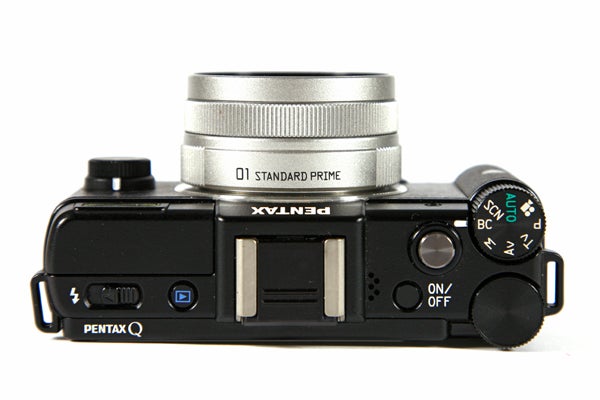
In addition to its Smart Effects, the Q also offers an equally generous array of Digital Filter effects. With 19 filter effects in total it’s by far the most generous set we’ve seen in a camera of this size, with specific options including: Toy Camera, High Contrast, HDR, Invert Colour, Extract Colour, Posterization, Fish-eye, Starbust and, of course, our old favourite Miniaturisation.
While these Smart Effects and Digital Filters can’t be combined, they can be accessed in an instant via the prominent four-point dial that sits on the front of the Q. Easily set up via the main Menu, this dial allows you to flick between stored presets in an instant, which in turn actively encourages you to make use of the Q’s built-in creative potential.
In addition to quick-accessing the camera’s Smart Effects and Digital Filters, this dial can also be used to switch between Custom Image presets and aspect ratios. Sadly, you can’t mix and match your presets, but overall it remains a flexible arrangement that enables you to shoot normally, but with your favourite creative effects available in an instant.
Lastly, the Q is able to record movies at a maximum 1920 x 1080p Full HD at 30fps, with further 720p and VGA options. Audio is strictly mono only, as there’s no port for an external microphone and recorded movies are stored as MPEG-4/H.264 files. While you can apply Custom Image settings to movies, it’s not possible to apply any of the Smart Effects or Digital Filters.
When looking at the camera’s design, the first thing that strikes you is that the Pentax Q really is tiny. In fact, it’s currently the smallest interchangeable lens camera available, and by some distance too. Remove the lens and the camera body is small even by regular fixed-zoom compact camera standards. And yet, with its all-metal outer construction the Q feels decidedly robust and well made. At 200g body only, or 237g with the 8mm standard prime lens attached, the Q has a nice, reassuring weight about it, too.
Styled very much like a miniaturised rangefinder, albeit one without a viewfinder, the Q sports a rounded-off finger grip. Given the tiny overall dimensions of the camera it’s at best a two-finger grip, however its rubberised finish along with a raised thumb-rest at the back combine to make the Q feel fairly secure in the hand. The big question for many users will be whether to secure the Q with a neck-strap (which makes the camera look somewhat toy-like and out of proportion), or to just settle for a wrist strap instead.
Lenses can be swapped by pressing the release catch on the front of the camera and then twisting the lens off as you would with a DSLR. You do need to be careful when swapping lenses though, as the sensor sits almost immediately behind the lens, which means it’s fully exposed once the lens has been removed and therefore highly susceptible to damage from fingers and dust. While the camera automatically activates a sensor-cleaning action every time it’s shut down, you really don’t want to be getting any dust on a sensor of this size in the first place as, proportionally, it’ll cover a larger part of the sensor’s surface than it would on a MFT or APS-C sensor, making it a) more noticeable and b) harder to correct.
The Pentax Q takes its name from the new Q-mount (reportedly the ‘Queen’ to Pentax’s ‘King’ K-mount for DSLRs). At present Pentax offers a range of five lenses – a 8.5mm f/1.9 Standard Prime, a 5-15mm f/2.8-4.5 Standard Zoom, a 3.2mm f/5.6 Fish-Eye, a 6.3mm, f/7.1 Toy Lens Wide and an 18mm f/8 Toy Lens Telephoto. Given the Q’s compact-sized sensor, a crop factor of 5.5x needs to be applied to work out the 35mm equivalent of these focal lengths. In this way, the 8.5mm Standard Prime equates to 47mm on a 35mm film camera.
The Q’s in-camera enu system should look instantly familiar to anyone who’s ever used a Pentax DSLR, although thankfully it remains easy enough to navigate for those who haven’t. While in shooting mode the directional buttons can be used to directly access ISO, White Balance, Drive mode and Flash settings, while the INFO button accesses a kind of ‘quick menu’ for other regularly accessed settings such as Custom Image, Digital Filters, Aspect Ratio, Image Stabilisation, Metering mode, AF mode, JPEG size/quality and suchlike. The only real complaint we have with overall operation is that the Q’s physical buttons are very small, which makes them a bit fiddly to use.
Start-up time is around the three second mark, which isn’t particularly quick. Using the Q in Single-shot mode we were able to shoot around one full-res JPEG every two seconds, which is pretty slow. There was no upper limit on the number of shots we could take in this way though. Switching to Continuous (Low) we were able to shoot at just under 1.5fps, again at full resolution with no upper limit on the number of shots. In Continuous (High) we were able to shoot at the claimed 5fps, although we actually managed 10 shots (as opposed to the claimed five) before the buffer filled and the camera slowed right down to approximately 0.5fps.
Autofocus performance, while adequate in the majority of situations, is still a little slow overall. Indeed, we found the Q’s AF speed to be more comparable to a regular mid-range compact than a £600 CSC – we’d expected something a bit faster. There’s also a notable delay between pressing the shutter button and the camera actually firing – again, in much the same way as a regular compact.
The 3in, 460k-dot monitor is fine when used indoors or away from direct sunlight outdoors, but doesn’t cope very well with direct sunlight. Somewhat annoyingly, when in shooting mode the Q displays underexposed and overexposed areas with yellow and red fill-colours. Try as we might, we couldn’t find a way to switch this function off. Battery life isn’t great either; we managed just over 200 images on a single charge before the juice ran out.
While the Pentax Q might look like a miniature DSLR, at heart it’s very much an advanced compact and this needs to be kept in mind when judging overall image quality. Compared against other compacts using a 1/2.3in sensor, including those that fall within the high-end or advanced compact segment of the market, we’re pleased to report that the Q performs exceptionally well. Indeed, to revisit the bold claim made by Pentax that we referenced at the beginning of this review it’s certainly true that the Q can deliver “high-contrast images, rich in gradation and texture,” and much more besides. As far as regular compact cameras go, the Pentax Q delivers some of the best image quality we’ve yet seen, with mid-range ISO performance particularly strong. 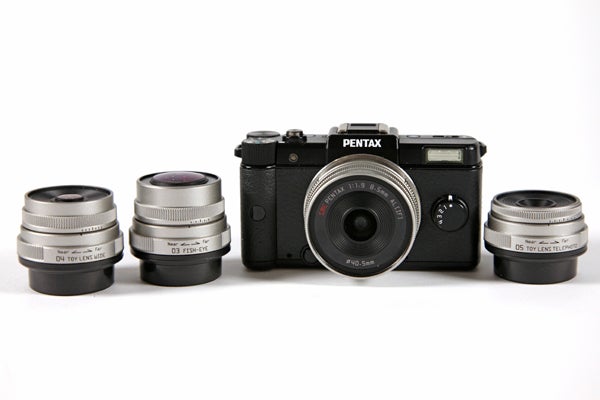
Between ISO 125 and ISO 400, images remain sharp and free of noise, while ISO 800 shows only minor signs of noise with impressive levels of detail retained, especially in shadow areas. It was ISO 1600, however, that really left us impressed; whereas the vast majority of compacts tend to deliver fairly poor results at ISO 1600, the Pentax Q is still producing pretty good images. Under close examination, detail can be seen to have softened, but noise is kept largely at bay, with overall image quality remaining high enough to view and/or print at larger sizes that would usually be the case.
Metering is generally quite consistent, although as with Pentax DSLRs, the Q has a tendency to preserve highlight detail through underexposure. Thankfully, the camera offers /-2EV compensation to help out in situations where you want to intervene. We didn’t encounter any problems with Automatic White Balance, with the Q proving consistent at metering for variations in colour temperature.
Sadly though, there are some limitations, with the Q’s compact-sized sensor severely limiting how shallow a depth of field you can attain, even when shooting at maximum aperture. Even with the 8mm lens opened to f/1.9, you really need to be using the Q at its minimum focus distance (around 15cm) to really throw the background sharply out of focus. And while such close focusing might be ok for Macro and still-life work, it simply isn’t practical for larger subjects and for portraits. 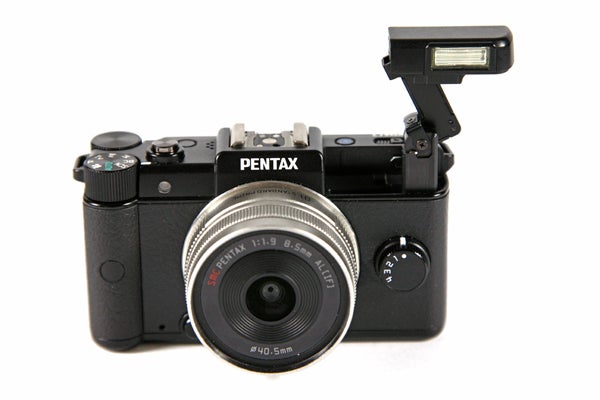
Clearly aware of this limitation Pentax has attempted to implement a solution in the form of a Blur Control shooting mode that can be accessed directly from the main mode dial. This basically uses image processing to accentuate the defocused areas of an image, with three levels of strength on offer. In theory it’s a nice idea, however in practice we found it to be somewhat flawed, often failing to properly distinguish our main subject and blurring random areas on the same focal plane, with the net result that some images end up looking like they’ve been put through one of those fake tilt-shift apps you can get for smartphones.
Verdict
Irrespective of its overall score, it’s hard not to warm to the Pentax Q. Not only does it look different, it is different, and for that alone kudos must go to Pentax for daring to tread a different path. The Q can deliver solid results when used as a regular digital camera, but what it really excels at is the ability to deliver effects-laden photography on the fly. The generous number of creative tools and the ease with which they can be used mark the Q out as a camera to experiment and have fun with, and that will surely bolster its appeal to many, irrespective of its inherent limitations. There are undoubtedly better compact system cameras available for photography enthusiasts, but for gadget lovers and casual snappers looking for something small and fun, the Pentax Q pretty much hits the spot. The £600 price tag is uncompetitive though, and sure to put plenty of people off.

The full ISO test still-life.

As this 100% crop shows the Pentax Q delivers noise-free images at ISO 125.

At ISO 200 images are still noise-free and display good shadow detail.

At ISO 400 shadow detail remains strong with only a minor softening of detail.

At ISO 800 whereas most 1/2.3in sensors are starting to fail, the Pentax Q is still producing pretty good results.

By ISO 1600 there is quite a noticeable softening in detail. However,
compared to the vast majority of compacts the overall results hold up
very well indeed.

By ISO 3200 the image has started to degrade quite noticeably.

The top sensitivity setting of ISO 6400 shows a dramatic loss of detail.
Thanks to a recent upgrade to the TrustedReviews content management system we’re now able to bring you full-size images. Simply click on the images below to see how they shape up when viewed at actual size.

The 8mm standard prime is capable of producing sharp images with good detail, even in murky light.
(1/125sec @ f/5.6, 8mm, ISO 125, AWB)

Using the standard Creative Tool setting, the Pentax Q produces lifelike colour and tone.
(1/80sec @ f/2.2, 8mm, ISO 125, AWB)

Used outdoors in the late autumn sun, the Pentax Q delivers pleasing results.
(1/160sec @ f/2.2, 8mm, ISO 250, AWB)

Given the Q’s 1/2.3in sensor, dynamic range is quite impressive.
(1/250sec @ f/3.2, 8mm, ISO 400, AWB)
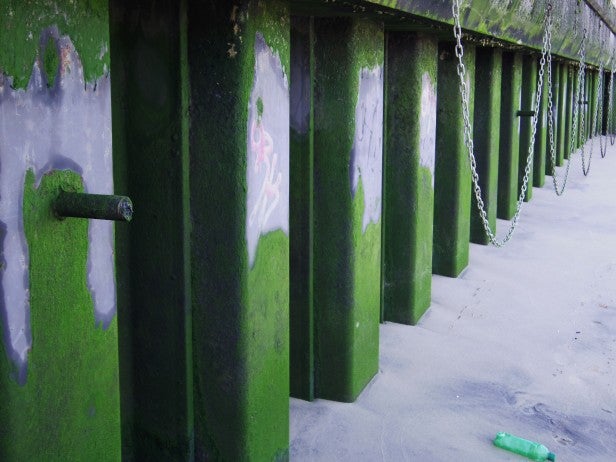
However, as this image shot at f/1.9 (with the nearest pillar set as the point of focus) demonstrates, it’s almost impossible to create a naturally shallow depth of field with the Pentax Q.
(1/200sec @ f/1.9, 8mm, ISO 125, AWB)

What the Q really excells at are in-camera creative effects. These can be used to spruce up even the most mundane of images.
(1/50sec @ f/1.9, 8mm, ISO 200, AWB)

The Pentax is able to deliver good low-light results.
(1/5sec @ f8, 8mm, ISO 200, AWB, tripod used)
The following selection of (downscaled) images show how the Pentax Q’s creative effects and digital filters can be applied to make exactly the same scene look very different (apologies for the wonky horizons!):


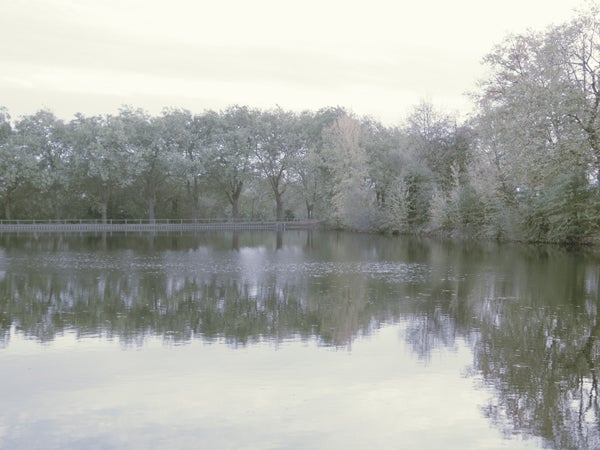




Trusted Score
Score in detail
-
Value 6
-
Design & Features 8
-
Image Quality 8
-
Build Quality 8
Features
| Camera type | Mirrorless Camera |
| Megapixels (Megapixel) | Megapixel |
| Image Sensor | CMOS |
| Image Stabilisation | Optical |
| LCD Monitor | 3" |
| Flash modes | Auto Flash |
| Video (max res/format) | 1920 x 1080 |

